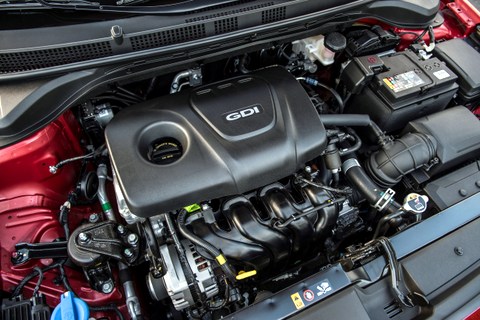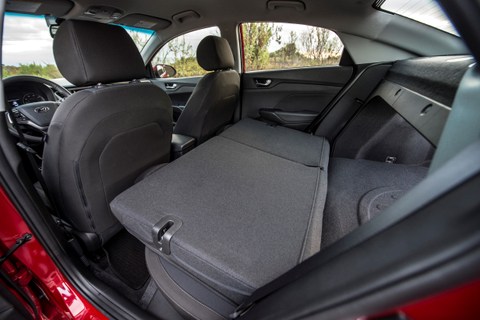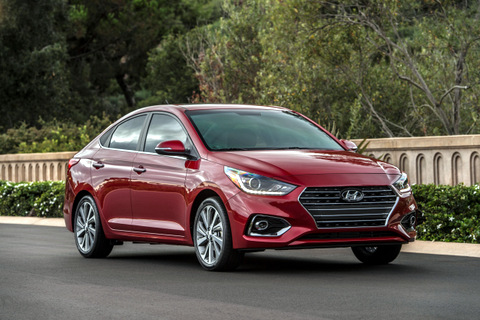Road Test Reveals Stylish Sedan With More Room, Great Small Car Value
The 2018 Hyundai Accent is the smallest and least-expensive vehicle from Hyundai, and with nearly 25 years of history and more than 1.2 million models sold, among its longest-serving and most-recognized nameplates. The Accent is all new for 2018, which marks this car the fifth generation. (Editor’s note: there are no significant changes to the 2019 Hyundai Accent.)

Yes, small crossovers have eclipsed subcompact cars on the sales charts, but these small automobiles continue to improve in terms of styling, sophistication, ride quality and safety, and there is no lack of buyer choices. The all-new 2018 Hyundai Accent will be competing with models that include the Chevrolet Sonic, Honda Fit, Nissan Versa, Toyota Yaris, Mazda3, Kia Rio and Ford Fiesta, among others. But it will have one disadvantage: The hatchback variant is no more, and the Accent is now offered solely as a four-door sedan.
The 2018 Hyundai Accent comes with a new trim structure. The base model remains the SE, but the mid-level SEL and top-line Limited are new. Pricing starts at $14,995 for the six-speed manual SE; the automatic is $1,000 more. Coming only with automatics, the SEL carries a price of $17,295 and the Limited is $18,895. All prices exclude $885 delivery.
The Accent doesn’t offer any options, though, just port-installed accessories. It lacks some features entirely, things like navigation and leather upholstery.
After driving the 2018 Hyundai Accent for a week, these are the five things I learned.
-
Styling
Previous Accents gave an appearance of just “basic” transportation with little or no allure. I think the 2018 Hyundai Accent could be the best-looking subcompact car you can buy today. There is nothing about the new exterior styling that says “basic” transportation or “econobox.” It looks sleek and modern, with a low-key elegance that telegraphs as being almost European. It’s a subcompact car that you would be pleased to park next to one twice the price.

When it comes to the appearance of its sheet metal, the 2018 Accent looks like a smaller version of an Elantra compact, which looks like a smaller version of a Sonata midsize. And that’s a good thing. It helps the Accent look a bit more expensive than it actually is, especially from the front. The Accent’s six-sided prominent grille, along with a strong character line running from front to rear just below the beltline and sculpted lower body creases connecting the front and rear wheel wells take the Accent visually out of its size class.
Like almost every new car that rolls out of the factory these days, the 2018 Hyundai Accent sedan is a little bigger than the version that preceded it. The wheelbase stretches almost a half-inch and the overall length grows correspondingly. But the most significant increase is lateral. At 68.1 inches, the new sedan is 1.2 inches wider than its predecessor. That liberates interior space and avoids the small-car pitfalls of design.
-
Interior
The cabin is the first thing you see when you get behind the wheel in the morning and the last thing you glance at as you step out of the vehicle after driving home for the night. Even though it’s mostly rendered in hard plastics, the Accent’s cabin bears the marks of good taste in color combinations, grains and textures. As with the car’s exterior, the mood is tasteful so you won’t be embarrassed to drive your boss to lunch.

The Accent offers a front row that’s roomy enough to handle drivers of all sizes. The driver and front-passenger seats offer excellent legroom and good headroom, and the added width means no elbow bumping. The added length is most noticeable in the rear seats with more legroom. The rear seat can accept two tall passengers or three children.
A central touchscreen infotainment display is easy to see, and buttons and knobs for climate and audio functions are easy to see and use. There’s a satisfying array of tech goodies offered with the Accent. Bluetooth connectivity and a five-inch touchscreen are standard, and the range of options includes a seven-inch touchscreen, satellite radio and Apple CarPlay and Android Auto smartphone integration.
A six-way driver seat is standard, as is a 60/40 folding rear-seat and backup camera. Heated seats can be had up front if you opt for the top-end model. Mercifully, in this day and age, power windows, door locks and air conditioning all come standard even in a base subcompact Hyundai.
This Hyundai sedanlett comes with a trunk offering 13.7 cubic-feet of cargo space. That’s a respectable figure, and the Accent delivers greater cargo capacity than some rivals in this segment. The rear seats fold forward and give the ability to bring home six-foot long objects.
-
Beneath the Hood

Unlike the exterior and interior, changes under the 2018 Hyundai Accent’s hood are minimal. Displacement of the direct-injection 1.6-liter four-cylinder engine carries over, but its output—130 horsepower (hp), 119 pounds-feet (lb.-ft.)of torque—has diminished slightly from the outgoing model’s 137 hp and 123 lb.-ft. Those numbers are actually pretty respectable for this class of car. They are enough for the front-wheel drive Accent to reach 60 mph from a stop in a few ticks less than nine seconds.
Hyundai continues to offer a six-speed manual transmission, but for 2018, the manual shifter is available only in the Accent’s base model. The mid-grade and top-of-the-line models are equipped solely with a six-speed automatic.
-
Driving the 2018 Hyundai Accent
By their nature, subcompact cars like the 2018 Hyundai Accent do best in city and urban environments. Its small size made it both easy to maneuver and capable of squeezing into parking spots where larger cars may have trouble. And, as you might guess, our test driver had no problems keeping up with traffic on city streets.

There isn’t a lot of power, but the Accent isn’t a lot of car. A base model weighs just 2,502 pounds, while our automatic came in well below 2,700 pounds. The output is perfectly adequate to move that amount of metal around town, and the car didn’t fear highways. Yes, getting up to highway speeds and passing people wasn’t yippee ki-yay, but it got the job done as well as any car in its small car class.
Our Accent came with a cabin that was pleasantly serene, even when overtaking big trucks on the highway. That’s impressive for a car at this price point.
The transmission shifted smoothly, and it responded well to orders from my right foot. Beyond the accommodating character of its automatic transmission, the Accent’s dynamic strong suits are supple ride quality and accurate steering, with a higher level of tactility than many systems at this level.
Big horsepower and torque devotees will scoff at the idea that a car like the 2018 Hyundai Accent could be fun to drive. Au contraire! Driving a car with a small displacement engine has its own rewards on twisty backcountry roads. Kudos go to a 32 percent stiffer chassis and an improved suspension for handling tight curves beyond what’s expected from a subcompact.
-
Fuel Economy
The 2018 Hyundai Accent’s EPA fuel economy ratings are: 28-mpg city/38 highway/32 combined. But don’t forget, the EPA also reminds us that our fuel economy can vary depending on how the car is driven. For example, we drove very sensibly for 175 miles of highway driving and achieved 40.2 mpg, two mpg more than the EPA rating. Overall, after putting 289 miles on the odometer, fuel economy was 35.3 mpg. Apparently, our Accent’s fuel economy varied because of how I drove it.
The Takeaway

The 2018 Hyundai Accent is a grownup-looking little car both outside and in. In typical Hyundai fashion it is a value-oriented vehicle that is well-equipped with standard features. However, there is a deficiency in available safety features compared to rivals. A rearview camera is standard on all models, and forward collision mitigation is standard on the Limited trim. But no other driver-assistant features are available. If you want features such as adaptive cruise control, lane-departure warning and lane-keeping assist, in addition to forward collision mitigation you will need to consider the Honda Fit or Toyota Yaris.
On the plus side, the 2018 Hyundai Accent offers a vehicle warranty that competitors don’t come close to—five years/60,000 miles overall; 10 years/100,000 miles for the powertrain.
Related Stories You Might Enjoy—Hyundai Choices/Subcompact Choices
Road Test: 2019 Hyundai Veloster Turbo R-Spec
Riad Test: 2018 Hyundai Elantra
Road Test: 2018 Hyundai Sonata Hybrid
News: 2019 Hyundai Kona Compact Crossover Goes Electric
Road Test: 2018 Hyundai Ioniq PHEV
Road Test: 2018 Toyota Yaris hatchback
Road Test: 2018 Honda Fit Sport
Road Test: 2017 Mazda3
Road Test: 2018 Kia Rio
Road Test: 2014 Nissan Versa Note
Make sure to opt-in to the Clean Fleet Report newsletter (top right of page) to be notified of all new stories and vehicle reviews.
Disclosure:
Clean Fleet Report is loaned free test vehicles from automakers to evaluate, typically for a week at a time. Our road tests are based on this one-week drive of a new vehicle. Because of this we don’t address issues such as long-term reliability or total cost of ownership. In addition, we are often invited to manufacturer events highlighting new vehicles or technology. As part of these events we may be offered free transportation, lodging or meals. We do our best to present our unvarnished evaluations of vehicles and news irrespective of these inducements.
Our focus is on vehicles that offer the best fuel economy in their class, which leads us to emphasize electric cars, plug-in hybrids, hybrids and diesels. We also feature those efficient gas-powered vehicles that are among the top mpg vehicles in their class. In addition, we aim to offer reviews and news on advanced technology and the alternative fuel vehicle market. We welcome any feedback from vehicle owners and are dedicated to providing a forum for alternative viewpoints. Please let us know your views at publisher@cleanfleetreport.com.

1 thought on “5 Things I Learned When I Drove The 2018 Hyundai Accent”